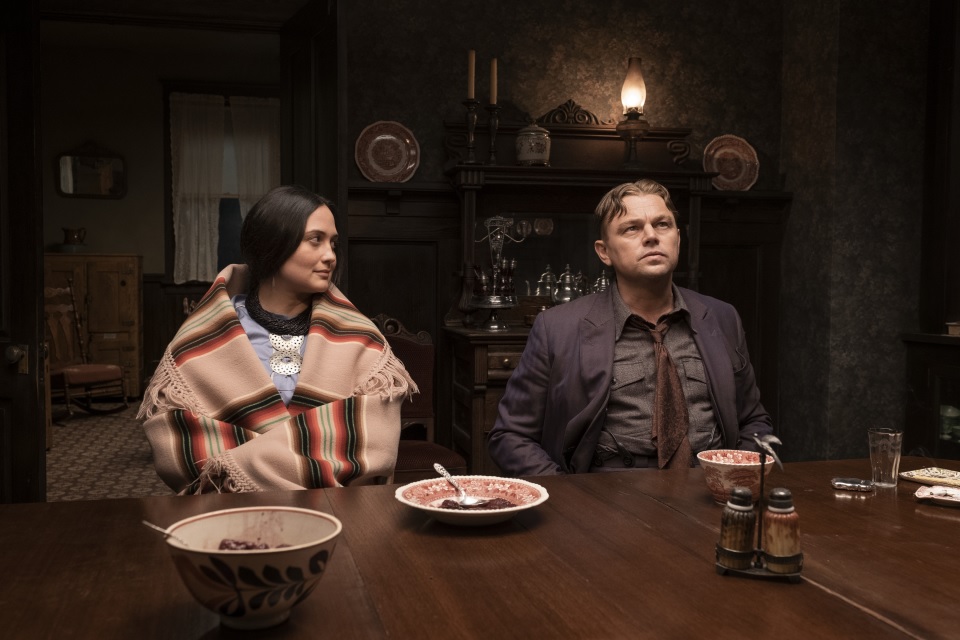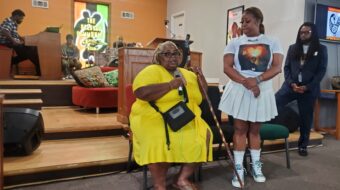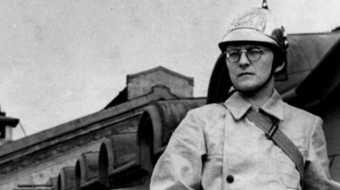
It seems only fitting that the new film Killers of the Flower Moon would make its debut during the month of Halloween. This true-crime horror story is not one filled with the kinds of monsters who hide under beds or in dark corners. This one highlights a dark span of history not often shared with the general public. Killers of the Flower Moon beautifully interweaves the strength and rich culture of the Osage people within a tragic re-telling of the murders—fueled by greed and racism—that afflicted them.
Directed and produced by Martin Scorsese (The Irishman, Gangs of New York), who co-wrote the screenplay with Eric Roth (Dune), Killers of the Flower Moon is based on the 2017 book of the same name by David Grann. The plot centers on a series of Oklahoma murders in the Osage Nation during the 1920s, committed after oil was discovered on tribal land.
At the center of this story is the romantic relationship between Mollie Burkhart (Lily Gladstone) who is a full-blooded Osage, and her husband Ernest Burkhart (Leonardo DiCaprio). Ernest is the nephew of businessman William King Hale (Robert De Niro) who, like many white men living in Oklahoma at the time, has his eye on obtaining the wealth of the Osage people by any means necessary.
In the early 1900s, oil brought a fortune to the Osage Nation, who became some of the richest people in the world during this time. Yet, the wealth of these Indigenous people immediately attracted white newcomers, who manipulated, extorted, and stole as much Osage money as they could before ultimately resorting to murder.
This is a true story.
The murders were gruesome, blatant, and all but ignored by the U.S. government for years before any justice was seen. A part of the original book’s angle is how the Osage murder mystery was the first big case of the then-newly-created Bureau of Investigation (the agency that would later become the FBI). While Scorsese does include this element, he chooses to dive deep into the perspective of the Osage people and their views on the murders. This gives a very personal take on such an expansive and far-reaching story.
In our present times, one too many Indigenous women have gone missing or have been murdered with no resolution. Killers of the Flower Moon hits a relevant chord by showing how Osage women were targeted for marriage by white men as a means to obtain their wealth after their (often untimely and suspicious) deaths. Yet, director Scorsese does this in a way that does not come off as exploitative or ghastly for shock value. The brutality is there, unflinching and raw, yet it is showcased beside the vibrancy and spirit of these women. They are not faceless victims, but key players attempting to live their lives despite the unspoken targets on their backs.
That theme of grace and vivaciousness is at the heart of the film, and it’s best embodied through Lily Gladstone’s portrayal of Mollie.
It is through her perspective that we’re allowed to see the depth of the brutality that affected those close to her and her community. In a story with so many questionable and grey characters, Mollie serves as a beacon of light. Gladstone plays her part with a sense of wisdom intermingled with a need for acceptance and love. Her chemistry with DiCaprio’s troubled Ernest is what grounds the film and makes it more than a disassociated true-crime piece. These characters don’t allow the audience to keep an arm’s-length distance from the happenings. Viewers are drawn fully into the story, forced to experience the rollercoaster of emotions and danger.
The cinematography also feels like a character in its own right, shaping how the narrative is conveyed. Cinematographer Rodrigo Prieto (Barbie, The Irishman) plays with several different styles throughout the progression of the story. It helps to draw viewers further into this epic American Western. The style pushes against the idea of having a set and rigid formula. This may throw off some viewers, with the constant cinematographic changes, but if it is treated as a reflection of the plot’s twists and turns, then these style switches make complete sense.
The film also has a massive runtime of 206 minutes. That’s nearly three-and-a-half hours to cover this tale that stretches over several years. It’s been said that many filmmakers could use a good editor to cut at least 30 minutes of their work. That is not the case with Killers of the Flower Moon. It’s not necessarily that every moment in the film is action-packed, but rather every moment feels like it counts—even the quiet ones.

The way the story is structured beckons the viewer to settle in for the long haul. This is in sharp contrast to movies that can feel like something to be consumed and quickly forgotten. That’s because this film touches on living history. The relationship between the United States and the Indigenous people of this land has been one filled with many moments of strife and occasional moments of peace. Throughout, it has been one riddled with exploitation, violence, racism, and contradiction.
Also worth noting is the connection made in the movie between the 1921 Tulsa race massacre (a two-day-long white supremacist terrorist attack on the Black people of Tulsa who had accumulated a certain amount of wealth) and what is happening to the Osage Nation. This deserves attention, as it shows these dark moments in history—moments of greed and exploitation—are not one-offs, but rather have served as key drivers of the U.S.’ story. These moments reflect on who is often allowed to be powerful and wealthy.
Killers of the Flower Moon is a saga that will hopefully push viewers to seek out more info on the history it touches upon. The subject matter is intense, but it is a story that deserves to be told.
Killers of the Flower Moon premiers in theaters Oct. 20, 2023.
We hope you appreciated this article. At People’s World, we believe news and information should be free and accessible to all, but we need your help. Our journalism is free of corporate influence and paywalls because we are totally reader-supported. Only you, our readers and supporters, make this possible. If you enjoy reading People’s World and the stories we bring you, please support our work by donating or becoming a monthly sustainer today. Thank you!










